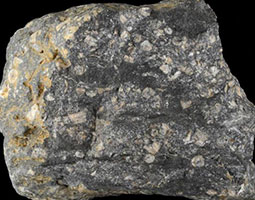Description

Most limestones form in shallow, calm, warm marine waters. That type of environment is where organisms capable of forming calcium carbonate shells and skeletons can easily extract the needed ingredients from ocean water. When these animals die, their shell and skeletal debris accumulate as a sediment that might be lithified into limestone. Their waste products can also contribute to the sediment mass. Limestones formed from this type of sediment are biological sedimentary rocks. Their biological origin is often revealed in the rock by the presence of fossils.
Some limestones can form by direct precipitation of calcium carbonate from marine or fresh water. Limestones formed this way are chemical sedimentary rocks. They are thought to be less abundant than biological limestones.
Uses
Limestone is a rock with an enormous diversity of uses. It could be the one rock that is used in more ways than any other. Most limestone is made into crushed stone and used as a construction material, as a crushed stone for road base and railroad ballast, as an aggregate in concrete and is fired in a kiln with crushed shale to make cement.
Source